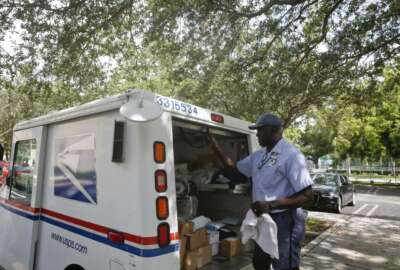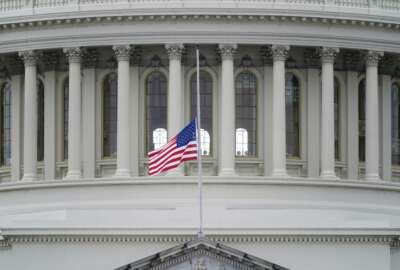USPS defends slower mail to achieve more reliable delivery
The Postal Service’s regulatory agency is in the final stretch of drafting an advisory opinion that, if favorable, would give USPS approval to slow first-clas...
The Postal Service’s regulatory agency is in the final stretch of drafting an advisory opinion that, if favorable, would give USPS approval to slow first-class mail delivery standards.
USPS officials told the Postal Regulatory Commission (PRC) on Wednesday its proposed changes would affect nearly 40% of first-class mail volume, and would go into effect as early as the first quarter of next year.
By widening out first-class mail delivery to four- and five-day delivery in some cases, USPS is looking to cut costs and provide a more consistent level of service — a metric USPS management believes its customers value more than overall speed.
The commission’s opinion, however, isn’t binding, and USPS is free to implement the slower service standards, even if the PRC doesn’t issue a favorable opinion.
PRC Chairman Michael Kubayanda said he expects USPS management will consider the commission’s advisory opinion, regardless of the outcome.
“The law does not give this commission a veto over operational and service decisions of the Postal Service,” Kubayanda said.
USPS Vice President for Logistics Robert Cintron said the agency’s core focus of the service change is to provide “consistent, reliable [and] predictable service.”
“Being reliable means that if we say three days, four days or five days, that we deliver within that span,” Cintron said.
USPS seeks to reduce costs by shifting more of its mail volume away from air transportation contractors, which Cintron said have limited schedules and limited capacity to deliver mail.
“They are over capacity, but there’s not enough expansion,” Cintron said, adding that capacity fell by 80% in fiscal 2020. Cintron said the USPS ground network, however, only operates at 42% of its capacity and has “plenty” of room for growth.
Steve Monteith, the chief customer and marketing officer for USPS, said the plan would make USPS more efficient, while continuing to provide six-day delivery for mail and seven-day delivery for packages.
“It’s a cost-driven proposal, but it does take customers into consideration, from the standpoint of we are looking at building on that consistency and reliability — and also the viability, as we move forward in our ability to deliver for the long term,” Monteith said.
While USPS estimates an average 18% increase in delivery time nationally, Monteith said some would see a greater impact than others.
“It’s really a function of what volume is being mailed and where it’s being mailed to. There are areas of the country, where if they mail cross-country volume, they will have the greatest increase,” Monteith said.
Mail that travels the furthest — from Maine to San Diego, or Miami to Seattle, for example — would likely fall into the 9% of mail that would take up to 5 days to deliver
“I don’t necessarily concede the point that delivering mail within five days isn’t fast in terms of certain types of mail,” Monteith said.
Cintron said USPS has some data on the service breakdown between rural and urban delivery, but said the agency hasn’t been able to measure the impact this would have on demographics such as the elderly, veterans or low-income customers.
“I’m not sure how we would capture the data for all of those categories,” Cintron said.
Members of the commission have expressed support of the USPS push for more reliable delivery, even if some of those deliveries take longer.
Commissioner Ann Fischer said USPS is “likely correct” that customers value reliability over speed of delivery.
Fischer said PRC receives thousands of letters, emails and cards from USPS customers every year, but a random sampling of correspondence from April, she said encapsulates an inconsistent level of service.
Complaints include customers who received a box of dead baby chicks and individuals who received birthday cards in the mail, but not the gift cards inside.
Another customer gave high marks to her regular letter carrier, but complained mail is either delayed or not delivered at all.
“I do believe that if the proposal can improve reliability so that customers actually received their mail within the plan timeframe. I do think that that’s movement in the right direction,” Fischer said.
Monteith said USPS in its 10-year reform plan expects to offset continued declines in first-class mail volume with steady increases in its package business.
To accommodate this shift, USPS seeks to remove mail-sorting equipment from processing plants to store packages, and make room for 138 package-sorting machines it expects to have up and running before this year’s peak holiday rush.
“This is really rebalancing the whole network for the new reality of our total volume, that we have to handle the combination of declining mail volumes with growing package volume and positioning us to handle that volume in the most efficient manner,” Monteith said.
USPS, meanwhile, is also seeking a slower standard for its first-class package service, which is used for everything from small electronics to medicines.
USPS said the changes downgrade service standards for more than 30% of first-class packages.
The agency seeks to move away from relying on air transportation — and would instead deliver more of its packages through ground transportation.
Copyright © 2024 Federal News Network. All rights reserved. This website is not intended for users located within the European Economic Area.
Jory Heckman is a reporter at Federal News Network covering U.S. Postal Service, IRS, big data and technology issues.
Follow @jheckmanWFED






